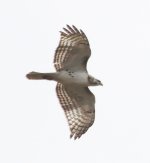Have just completed the College Station Christmas Bird Count survey today - south-central Texas. We got this hawk, which we thought was perhaps a juvenile Cooper's due to the long tail, but it is very pale below with few breast markings.
Help would be greatly appreciated as I have to get the sightings forms in today.
TIA
HelenB
Help would be greatly appreciated as I have to get the sightings forms in today.
TIA
HelenB
Attachments
Last edited:







